Abstract
The immunoregulatory function of the complement system has been the focus of many investigations. In particular, fragments of complement factor C3 have been shown to play a role in B-lymphocyte activation and proliferation, lymphokine production, and the generation of in vitro antibody production. Purified pneumococcal polysaccharides (PS) can induce direct activation of C3 via the alternative pathway. Using sera of C1q-deficient patients and healthy subjects, we demonstrated that C3d, a split product of C3 that is generated after degradation of iC3b, can be bound to PS antigens. The binding of C3d to PS can occur in the absence of specific antibodies. Subsequently, we showed that PS complexed with C3d can be recognized by complement receptor type 2 that is expressed on B cells. Treatment of B cells with a monoclonal antibody recognizing the C3d-binding site of complement receptor type 2 reduces the binding of PS-C3d to the cells. In addition, we showed that PS4 complexed with C3d exerted an increased immunogenicity compared with free PS4. Our results show that the complement system plays a role in the activation of PS-specific B cells, carrying membrane receptors for C3d. Consequently, the complement system plays a regulatory role in the antibody response to T-cell-independent type 2 antigens such as PS.
Full text
PDF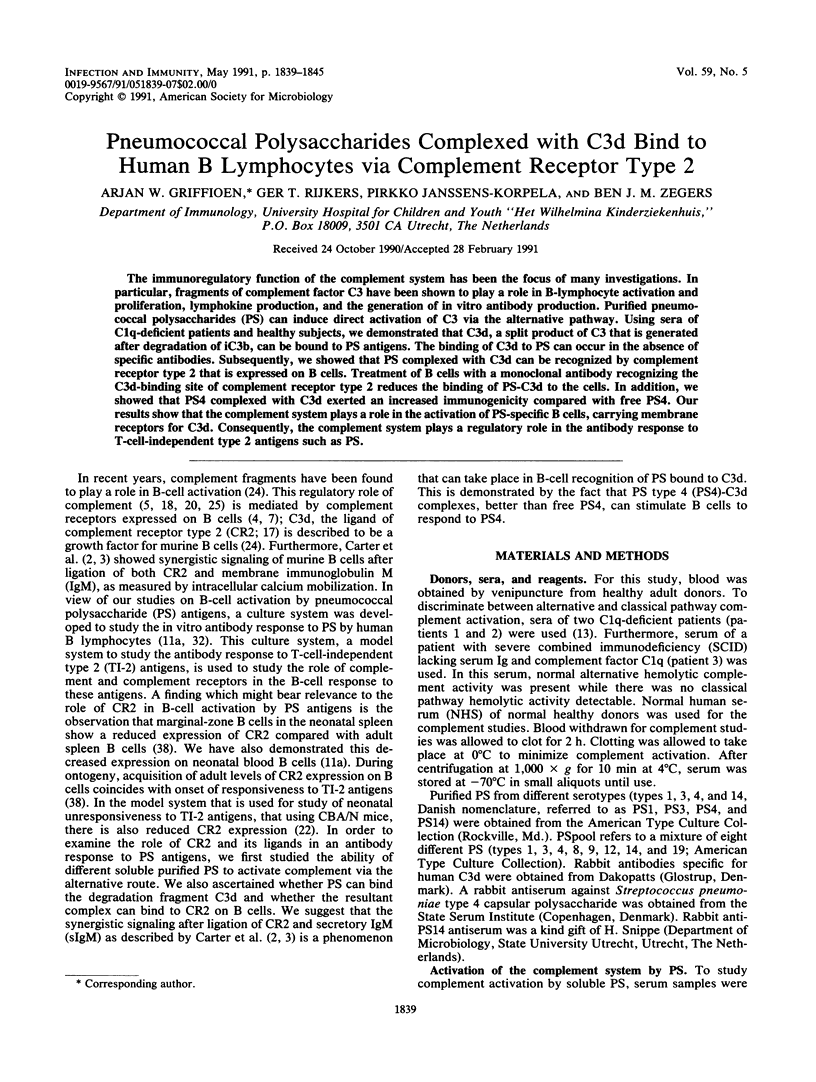
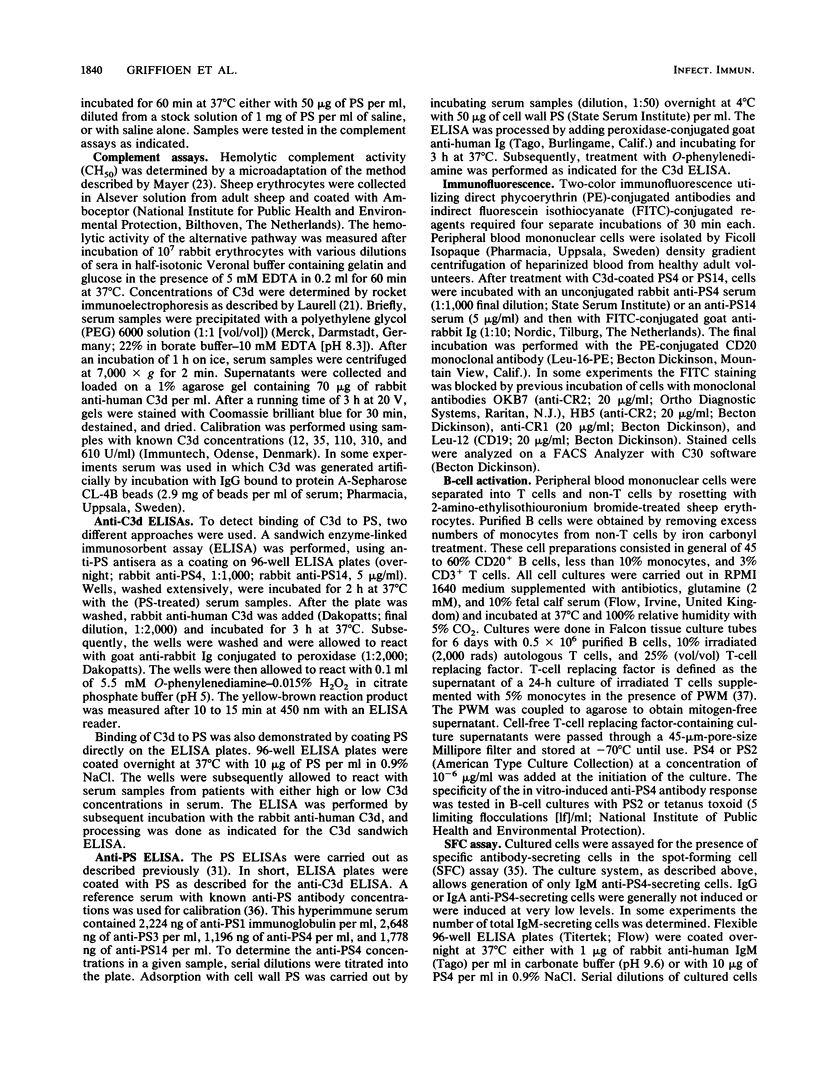
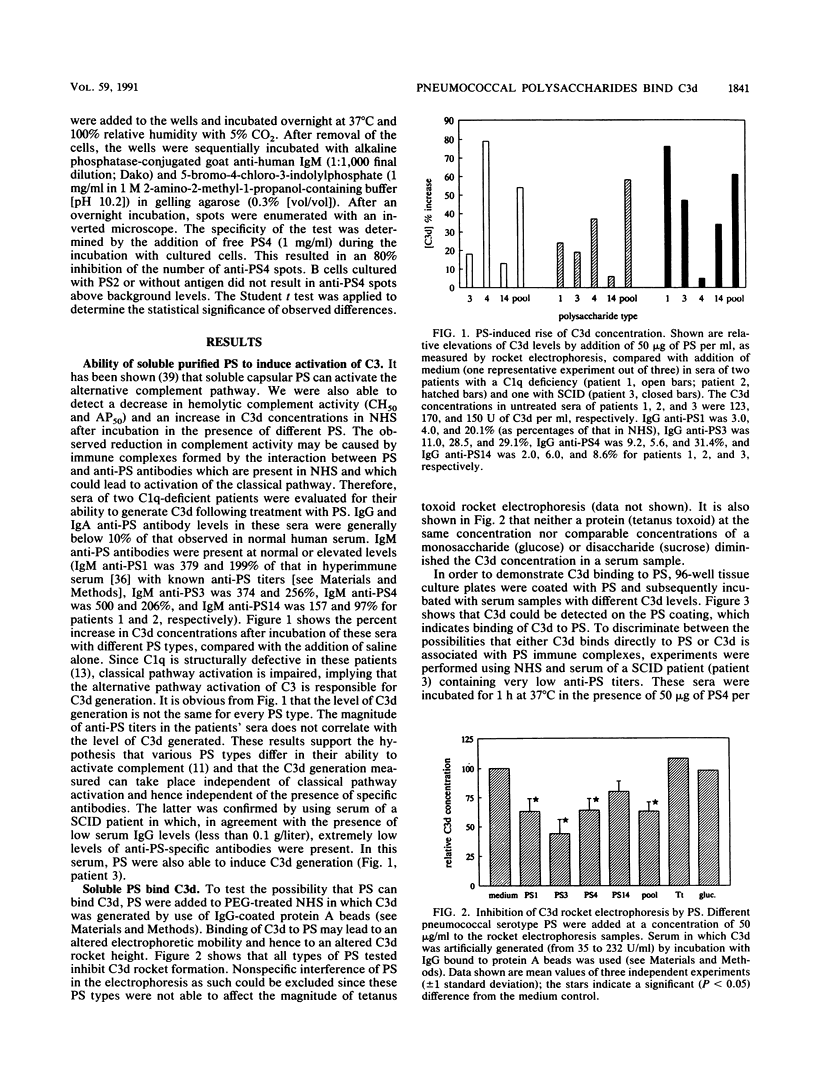
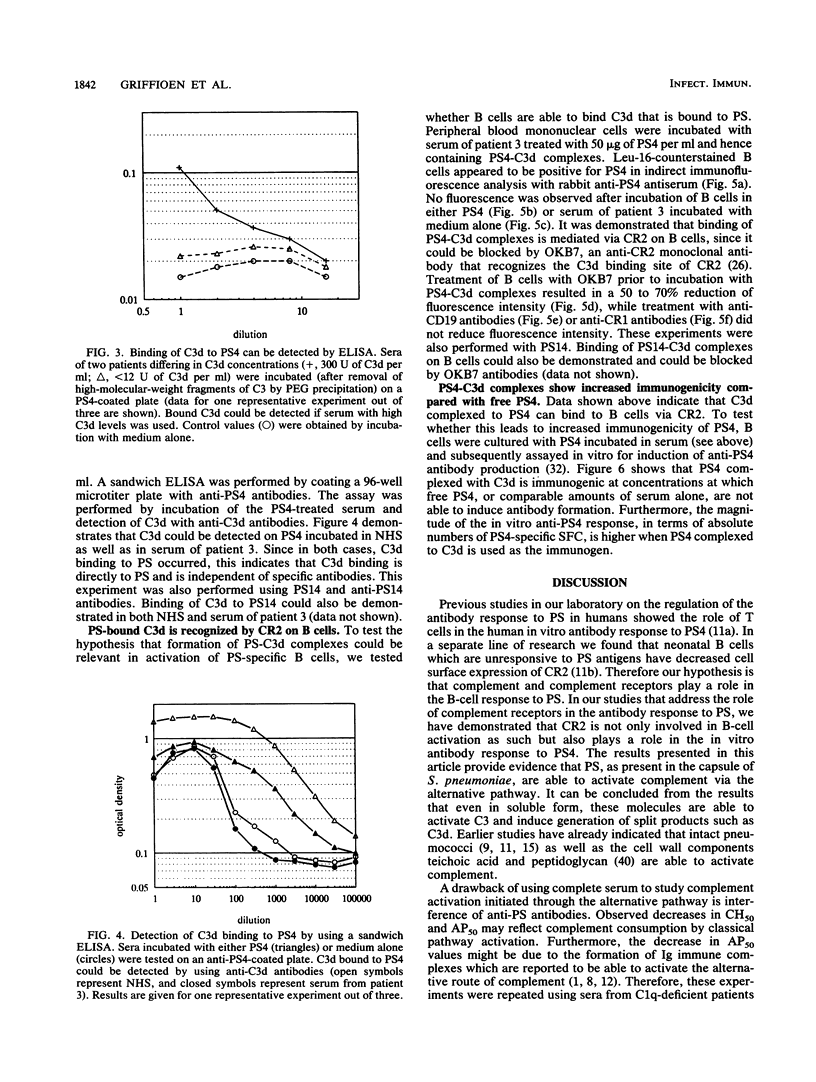
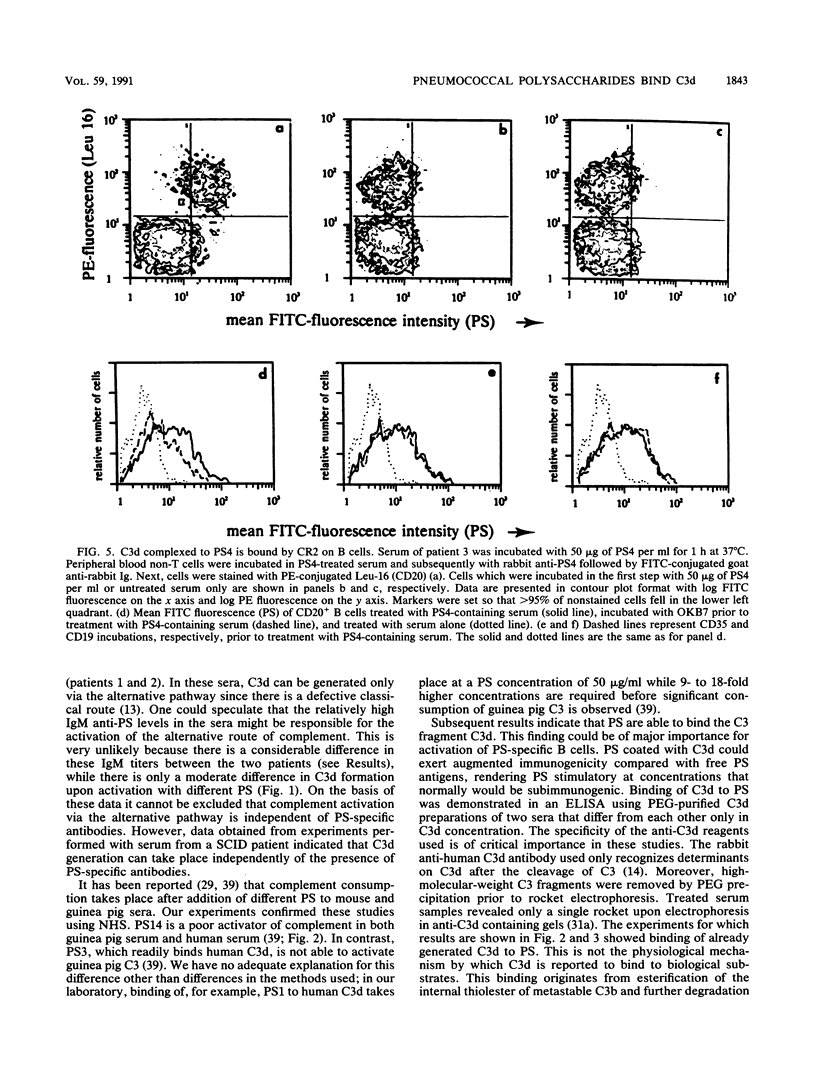
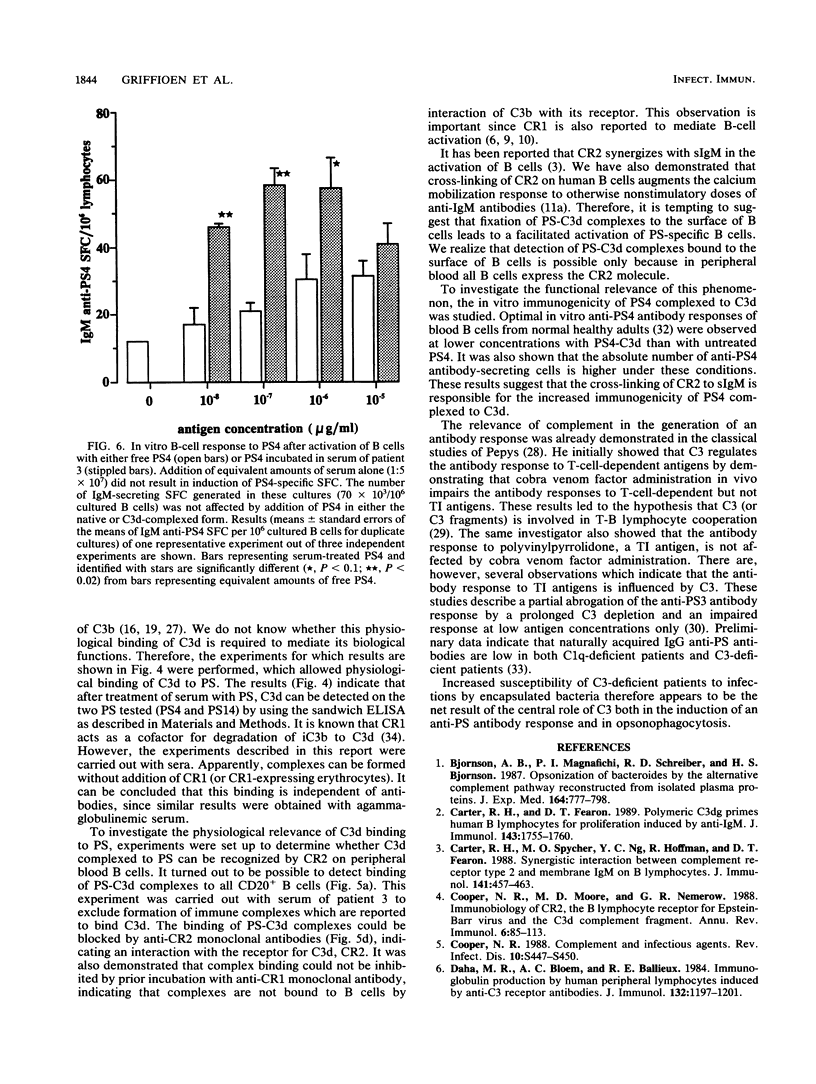
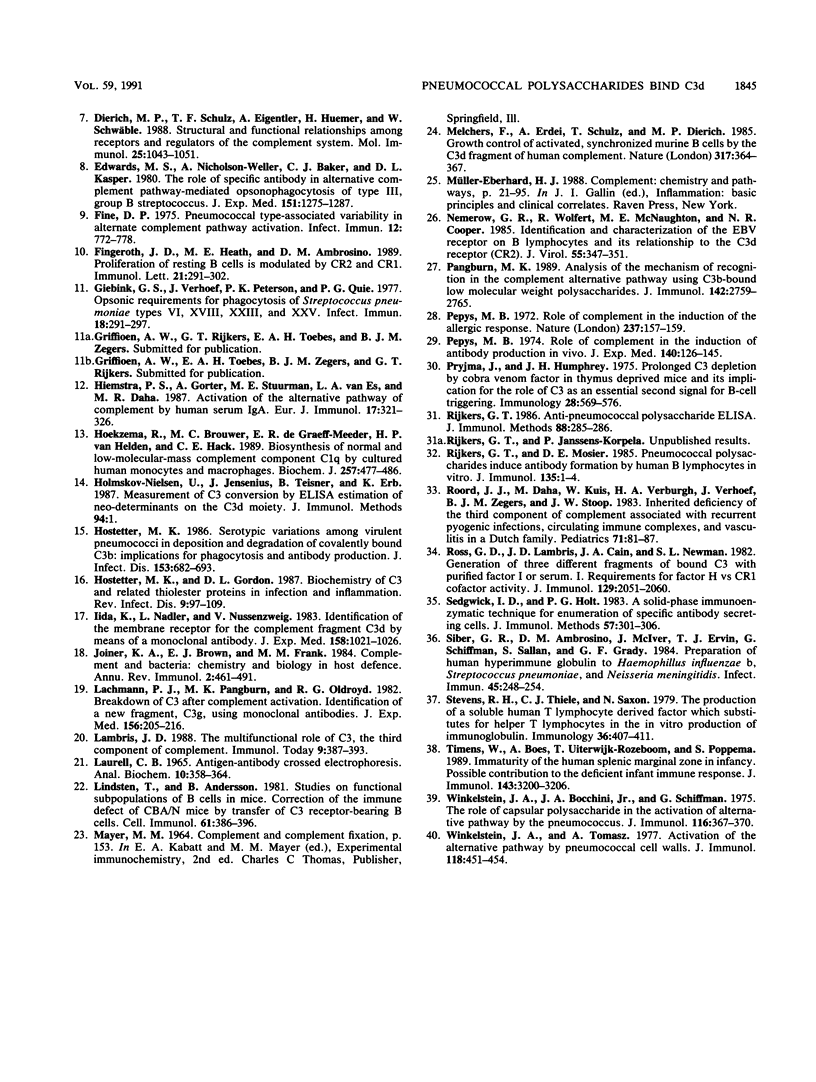
Selected References
These references are in PubMed. This may not be the complete list of references from this article.
- Bjornson A. B., Magnafichi P. I., Schreiber R. D., Bjornson H. S. Opsonization of bacteroides by the alternative complement pathway reconstructed from isolated plasma proteins. J Exp Med. 1987 Mar 1;165(3):777–798. doi: 10.1084/jem.165.3.777. [DOI] [PMC free article] [PubMed] [Google Scholar]
- Carter R. H., Fearon D. T. Polymeric C3dg primes human B lymphocytes for proliferation induced by anti-IgM. J Immunol. 1989 Sep 15;143(6):1755–1760. [PubMed] [Google Scholar]
- Carter R. H., Spycher M. O., Ng Y. C., Hoffman R., Fearon D. T. Synergistic interaction between complement receptor type 2 and membrane IgM on B lymphocytes. J Immunol. 1988 Jul 15;141(2):457–463. [PubMed] [Google Scholar]
- Cooper N. R. Complement and infectious agents. Rev Infect Dis. 1988 Jul-Aug;10 (Suppl 2):S447–S449. doi: 10.1093/cid/10.supplement_2.s447. [DOI] [PubMed] [Google Scholar]
- Cooper N. R., Moore M. D., Nemerow G. R. Immunobiology of CR2, the B lymphocyte receptor for Epstein-Barr virus and the C3d complement fragment. Annu Rev Immunol. 1988;6:85–113. doi: 10.1146/annurev.iy.06.040188.000505. [DOI] [PubMed] [Google Scholar]
- Daha M. R., Bloem A. C., Ballieux R. E. Immunoglobulin production by human peripheral lymphocytes induced by anti-C3 receptor antibodies. J Immunol. 1984 Mar;132(3):1197–1201. [PubMed] [Google Scholar]
- Dierich M. P., Schulz T. F., Eigentler A., Huemer H., Schwäble W. Structural and functional relationships among receptors and regulators of the complement system. Mol Immunol. 1988 Nov;25(11):1043–1051. doi: 10.1016/0161-5890(88)90136-8. [DOI] [PubMed] [Google Scholar]
- Edwards M. S., Nicholson-Weller A., Baker C. J., Kasper D. L. The role of specific antibody in alternative complement pathway-mediated opsonophagocytosis of type III, group B Streptococcus. J Exp Med. 1980 May 1;151(5):1275–1287. doi: 10.1084/jem.151.5.1275. [DOI] [PMC free article] [PubMed] [Google Scholar]
- Fine D. P. Pneumococcal type-associated variability in alternate complement pathway activation. Infect Immun. 1975 Oct;12(4):772–778. doi: 10.1128/iai.12.4.772-778.1975. [DOI] [PMC free article] [PubMed] [Google Scholar]
- Fingeroth J. D., Heath M. E., Ambrosino D. M. Proliferation of resting B cells is modulated by CR2 and CR1. Immunol Lett. 1989 Jun 15;21(4):291–301. doi: 10.1016/0165-2478(89)90022-9. [DOI] [PubMed] [Google Scholar]
- Giebink G. S., Verhoef J., Peterson P. K., Quie P. G. Opsonic requirements for phagocytosis of Streptococcus pneumoniae types VI, XVIII, XXIII, and XXV. Infect Immun. 1977 Nov;18(2):291–297. doi: 10.1128/iai.18.2.291-297.1977. [DOI] [PMC free article] [PubMed] [Google Scholar]
- Hiemstra P. S., Gorter A., Stuurman M. E., Van Es L. A., Daha M. R. Activation of the alternative pathway of complement by human serum IgA. Eur J Immunol. 1987 Mar;17(3):321–326. doi: 10.1002/eji.1830170304. [DOI] [PubMed] [Google Scholar]
- Hoekzema R., Brouwer M. C., de Graeff-Meeder E. R., van Helden H. P., Hack C. E. Biosynthesis of normal and low-molecular-mass complement component C1q by cultured human monocytes and macrophages. Biochem J. 1989 Jan 15;257(2):477–486. doi: 10.1042/bj2570477. [DOI] [PMC free article] [PubMed] [Google Scholar]
- Holmskov-Nielsen U., Jensenius J. C., Teisner B., Erb K. Measurement of C3 conversion by ELISA estimation of neo-determinants on the C3d moiety. J Immunol Methods. 1986 Nov 20;94(1-2):1–6. doi: 10.1016/0022-1759(86)90207-3. [DOI] [PubMed] [Google Scholar]
- Hostetter M. K., Gordon D. L. Biochemistry of C3 and related thiolester proteins in infection and inflammation. Rev Infect Dis. 1987 Jan-Feb;9(1):97–109. doi: 10.1093/clinids/9.1.97. [DOI] [PubMed] [Google Scholar]
- Hostetter M. K. Serotypic variations among virulent pneumococci in deposition and degradation of covalently bound C3b: implications for phagocytosis and antibody production. J Infect Dis. 1986 Apr;153(4):682–693. doi: 10.1093/infdis/153.4.682. [DOI] [PubMed] [Google Scholar]
- Iida K., Nadler L., Nussenzweig V. Identification of the membrane receptor for the complement fragment C3d by means of a monoclonal antibody. J Exp Med. 1983 Oct 1;158(4):1021–1033. doi: 10.1084/jem.158.4.1021. [DOI] [PMC free article] [PubMed] [Google Scholar]
- Joiner K. A., Brown E. J., Frank M. M. Complement and bacteria: chemistry and biology in host defense. Annu Rev Immunol. 1984;2:461–491. doi: 10.1146/annurev.iy.02.040184.002333. [DOI] [PubMed] [Google Scholar]
- LAURELL C. B. ANTIGEN-ANTIBODY CROSSED ELECTROPHORESIS. Anal Biochem. 1965 Feb;10:358–361. doi: 10.1016/0003-2697(65)90278-2. [DOI] [PubMed] [Google Scholar]
- Lachmann P. J., Pangburn M. K., Oldroyd R. G. Breakdown of C3 after complement activation. Identification of a new fragment C3g, using monoclonal antibodies. J Exp Med. 1982 Jul 1;156(1):205–216. doi: 10.1084/jem.156.1.205. [DOI] [PMC free article] [PubMed] [Google Scholar]
- Lambris J. D. The multifunctional role of C3, the third component of complement. Immunol Today. 1988 Dec;9(12):387–393. doi: 10.1016/0167-5699(88)91240-6. [DOI] [PubMed] [Google Scholar]
- Lindsten T., Andersson B. Studies on functional subpopulations of B cells in mice. Correction of the immune defect of CBA/N mice by transfer of C3 receptor-bearing B cells. Cell Immunol. 1981 Jul 1;61(2):386–396. doi: 10.1016/0008-8749(81)90386-5. [DOI] [PubMed] [Google Scholar]
- Nemerow G. R., Wolfert R., McNaughton M. E., Cooper N. R. Identification and characterization of the Epstein-Barr virus receptor on human B lymphocytes and its relationship to the C3d complement receptor (CR2). J Virol. 1985 Aug;55(2):347–351. doi: 10.1128/jvi.55.2.347-351.1985. [DOI] [PMC free article] [PubMed] [Google Scholar]
- Pangburn M. K. Analysis of the mechanism of recognition in the complement alternative pathway using C3b-bound low molecular weight polysaccharides. J Immunol. 1989 Apr 15;142(8):2759–2765. [PubMed] [Google Scholar]
- Pepys M. B. Role of complement in induction of antibody production in vivo. Effect of cobra factor and other C3-reactive agents on thymus-dependent and thymus-independent antibody responses. J Exp Med. 1974 Jul 1;140(1):126–145. doi: 10.1084/jem.140.1.126. [DOI] [PMC free article] [PubMed] [Google Scholar]
- Pepys M. B. Role of complement in induction of the allergic response. Nat New Biol. 1972 May 31;237(74):157–159. doi: 10.1038/newbio237157a0. [DOI] [PubMed] [Google Scholar]
- Pryjma J., Humphrey J. H. Prolonged C3 depletion by cobra venom factor in thymus-deprived mice and its implication for the role of C3 as an essential second signal for B-cell triggering. Immunology. 1975 Mar;28(3):569–576. [PMC free article] [PubMed] [Google Scholar]
- Rijkers G. T., Mosier D. E. Pneumococcal polysaccharides induce antibody formation by human B lymphocytes in vitro. J Immunol. 1985 Jul;135(1):1–4. [PubMed] [Google Scholar]
- Rijkers G. T. Re.: Anti-pneumococcal polysaccharide ELISA. J Immunol Methods. 1986 Apr 17;88(2):285–286. doi: 10.1016/0022-1759(86)90017-7. [DOI] [PubMed] [Google Scholar]
- Roord J. J., Daha M., Kuis W., Verbrugh H. A., Verhoef J., Zegers B. J., Stoop J. W. Inherited deficiency of the third component of complement associated with recurrent pyogenic infections, circulating immune complexes, and vasculitis in a Dutch family. Pediatrics. 1983 Jan;71(1):81–87. [PubMed] [Google Scholar]
- Ross G. D., Lambris J. D., Cain J. A., Newman S. L. Generation of three different fragments of bound C3 with purified factor I or serum. I. Requirements for factor H vs CR1 cofactor activity. J Immunol. 1982 Nov;129(5):2051–2060. [PubMed] [Google Scholar]
- Sedgwick J. D., Holt P. G. A solid-phase immunoenzymatic technique for the enumeration of specific antibody-secreting cells. J Immunol Methods. 1983 Feb 25;57(1-3):301–309. doi: 10.1016/0022-1759(83)90091-1. [DOI] [PubMed] [Google Scholar]
- Siber G. R., Ambrosino D. M., McIver J., Ervin T. J., Schiffman G., Sallan S., Grady G. F. Preparation of human hyperimmune globulin to Haemophilus influenzae b, Streptococcus pneumoniae, and Neisseria meningitidis. Infect Immun. 1984 Jul;45(1):248–254. doi: 10.1128/iai.45.1.248-254.1984. [DOI] [PMC free article] [PubMed] [Google Scholar]
- Stevens R. H., Thiele C. J., Saxon A. The production of a soluble human T-lymphocyte derived factor which substitutes for helper T lymphocytes in the in vitro production of immunoglobulin. Immunology. 1979 Mar;36(3):407–413. [PMC free article] [PubMed] [Google Scholar]
- Timens W., Boes A., Rozeboom-Uiterwijk T., Poppema S. Immaturity of the human splenic marginal zone in infancy. Possible contribution to the deficient infant immune response. J Immunol. 1989 Nov 15;143(10):3200–3206. [PubMed] [Google Scholar]
- Winkelstein J. A., Bocchini J. A., Jr, Schiffman G. The role of the capsular polysaccharide in the activation of the alternative pathway by the pneumococcus. J Immunol. 1976 Feb;116(2):367–370. [PubMed] [Google Scholar]
- Winkelstein J. A., Tomasz A. Activation of the alternative pathway by pneumococcal cell walls. J Immunol. 1977 Feb;118(2):451–454. [PubMed] [Google Scholar]


